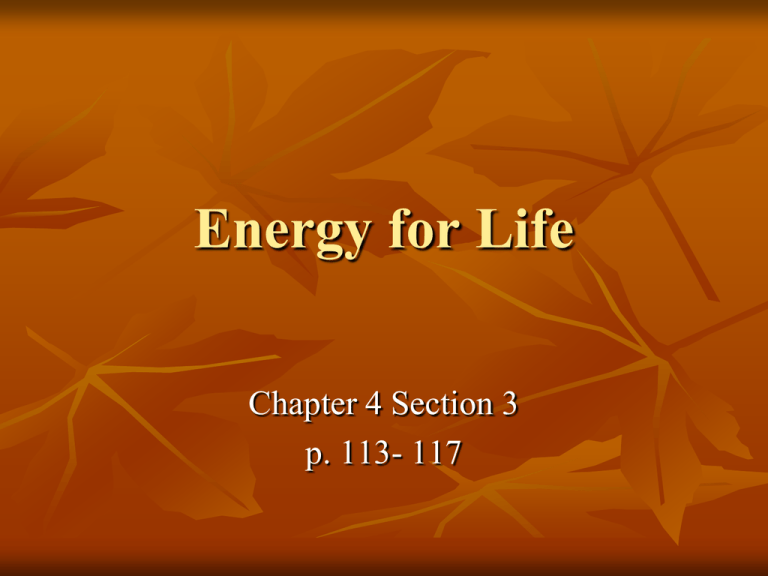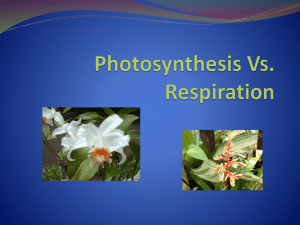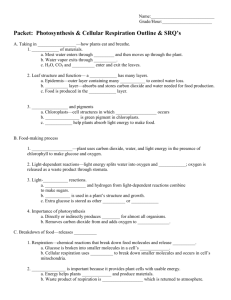Energy for Life
advertisement

Energy for Life Chapter 4 Section 3 p. 113- 117 A. Cells use Chemical Reactions Cells use chemical reactions to change the chemical energy stored in food into forms needed to perform cell activities A. Cells use Chemical Reactions 1. Metabolism – The total of all chemical reactions in an organism A. Cells use Chemical Reactions 2. Chemical reactions require enzymes (which cause, or speed up, or slow down reactions without themselves being changed and therefore can be used again and again.) B. Photosynthesis The process that plants and other organisms use to convert sunlight energy into chemical energy or sugars (glucose) to be used as food. B. Photosynthesis 1. Producers – organisms that make their own food Consumers – organisms that can not make their own food. B. Photosynthesis Chlorophyll and other pigments are used in photosynthesis to capture sunlight Which is used to produce sugar (glucose) and oxygen C. Respiration The process in which chemical reactions break down food molecules into simpler substances and release stored energy C. Respiration 1. Respiration of carbohydrates begins in the cytoplasm C. Respiration 1. Respiration of carbohydrates begins in the cytoplasm a. Carbohydrates are broken down into glucose molecules C. Respiration 1. Respiration of carbohydrates begins in the cytoplasm a. Carbohydrates are broken down into glucose molecules b. Each glucose molecule is broken down into two simpler molecules, releasing energy. + + C. Respiration 2. Respiration moves into the mitochondria C. Respiration 2. Respiration moves into the mitochondria a. The two simpler molecules are broken down again, releasing much more energy. + C. Respiration 2. Respiration moves into the mitochondria a. The two simpler molecules are broken down again, releasing much more energy. b. This process uses oxygen and produces carbon dioxide (CO2) and water as waste products. C6H12O6 + 6O2 6CO2 + 6H2O + energy glucose oxygen carbon dioxide water D. Fermentation Cells that do not have enough oxygen for respiration use this process to release some of the energy stored in glucose molecules D. Fermentation Cells that do not have enough oxygen for respiration use this process to release some of the energy stored in glucose molecules 1. Entire process occurs in the cytoplasm. D. Fermentation Cells that do not have enough oxygen for respiration use this process to release some of the energy stored in glucose molecules 1. Entire process occurs in the cytoplasm. 2. Produces lactic acid, alcohol, and carbon dioxide as wastes E. Comparisons Photosynthesis and respiration are almost the opposite of each other. E. Comparisons Photosynthesis and respiration are almost the opposite of each other. 1. Photosynthesis produces (end products are) glucose and oxygen which are used in respiration 6CO2 + 6H2O carbon dioxide water + energy sunlight energy C6H12O6 glucose + 6O2 oxygen E. Comparisons Photosynthesis and respiration are almost the opposite of each other. 1. Photosynthesis produces (end products are) glucose and oxygen which are used in respiration 2. Respiration produces (end products are) carbon dioxide and water, which are used in photosynthesis 6CO2 + 6H2O carbon + energy water sunlight dioxide C6H12O6 glucose C6H12O6 glucose + 6O2 oxygen energy + 6O2 oxygen 6CO2 + carbon dioxide 6H2O + energy water chemical energy







